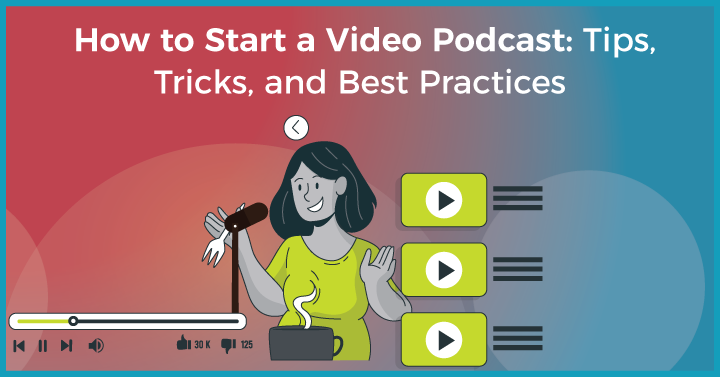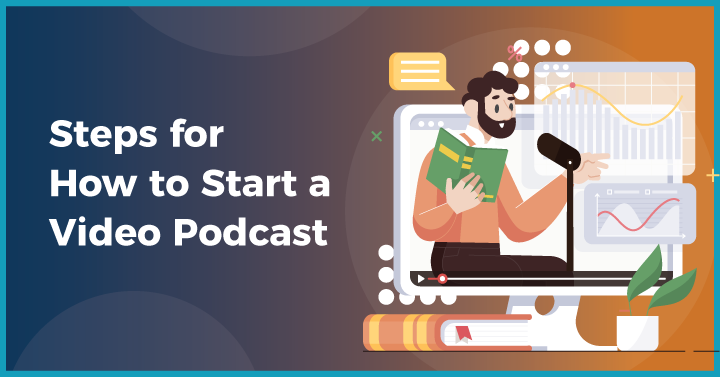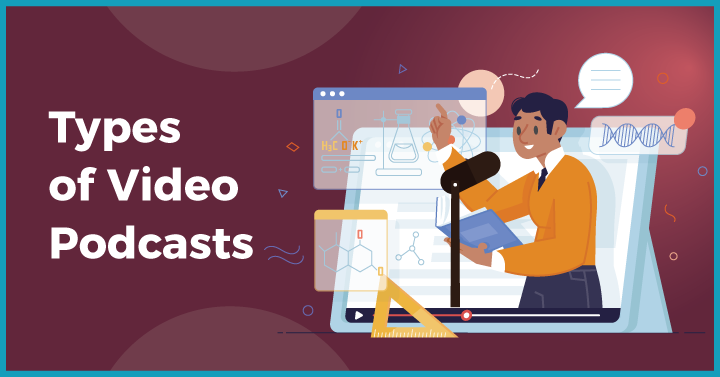
- What Are Video Podcasts?
- Benefits of Starting a Video Podcast
- Steps for How to Start a Video Podcast
- Step 1: Get Your Equipment in Order
- Step 2: Pick a Place to Record your Video Podcast
- Step 3: Select Your Video Podcast Software
- Step 4: Record Your Podcast
- Step 5: Edit the Podcast
- Step 6: Work on the Thumbnail
- Step 7: Upload Your Podcast
- Step 8: Promote Your Video Podcast Across Channels and Platforms
- Step 9: Monetize
- Types of Video Podcasts
- How Do You Monetize a Podcast Video?
- FAQs
Podcasts are by nature audio first, so it might seem counterintuitive to invest in expanding their reach using visual media. However, by exploring how to start a video podcast, you could not only increase your podcast’s audience but also improve your monetization options.
The popularity of podcasts has shown no real signs of slowing. At the same time, visual media is increasingly driving internet traffic. By combining these two trends, you can take your unique podcast concept in an exciting, more engaging direction.
1. What Are Video Podcasts?
Video podcasts are podcasts with additional video elements. At their simplest, they can just feature a static image or a basic audiogram. It’s also very common for podcasters to complement their audio with footage of themselves recording the show. Some popular video podcast examples include the Joe Rogan Experience and the Tim Ferris Show.
If you are wondering what a video podcast is called, by the way, the technical term is vodcast (video-on-demand cast).
2. Benefits of Starting a Video Podcast
2.1 More Engaging
Additional sensory input can help you increase audience engagement with your episodes. Interestingly, while research has suggested that audio can provoke stronger physiological responses in humans, people actually believe they respond more to video, which is why they tend to pay more attention to visual content. Plus, it’s pretty easy for someone’s attention to wander if they are only listening rather than looking as well as listening.
2.2 Easy to Share
Social media just isn’t optimized for audio-only content. In fact, some of the world’s most popular platforms, like YouTube, Instagram and TikTok, are specifically designed for visual feeds, particularly video. While you probably won’t want to upload a whole episode of your show to Instagram or TikTok, you can easily create short clips or soundbites to tease potential listeners and boost your audience base.
2.3 Help Increase Visibility
Teaser clips on social media are a proactive way to get your show noticed, but even just uploading a video to YouTube can boost your online presence. YouTube has an enormous audience – 2.6 billion users a month, according to one piece of research. Having a video in addition to audio means you can access that market and put your show in front of more eyeballs.
2.4 Better Monetization Opportunities
Simply by opening up your podcast to video platforms, you are creating more revenue streams than are available to audio content alone. For instance, YouTube’s Partner Program rewards creators who attract viewers, while Instagram has a marketplace to put creators in touch with brands that may want to sponsor posts.
2.5 Increases Credibility
Watching someone create their podcast lends a sense of authenticity. It allows the audience to peek behind the curtain and see that it is a real person putting energy into creating their show, rather than a Wizard of Oz with smoke and mirrors.
2.6 It’s a Natural Extension to Podcasts
Adding a visual element is an easy way to expand your reach without revolutionizing your whole format. Sure, purchasing camera equipment does entail an additional expense, and you’ll need to pay more attention to the appearance of your surroundings, but other than that, the changes are minimal. If you want to grow your audience and make more money with just a few tweaks, video is the natural next stage.
3. Steps for How to Start a Video Podcast

3.1 Step 1: Get Your Equipment in Order
As a podcaster, you’ll already have your microphone, headphones and so on. The main piece of additional video podcast equipment you’ll need is going to be a camera. This can be a digital still camera, a camcorder or even a webcam, depending on your budget and your show’s format (single host, interviews, etc.). You will also probably require a tripod.
3.2 Step 2: Pick a Place to Record your Video Podcast
When your podcast is purely audio, the most important thing is minimizing ambient sound and having good acoustics. It doesn’t matter, therefore, if you’re secreted away in a closet. Who’s going to know? Well, with video, you’ll need to move out of that closet and into a space that looks somewhat professional.
3.3 Step 3: Select Your Video Podcast Software
As you are planning out how to start a video podcast, make sure you consider any software requirements. If you intend to interview people remotely, you’ll want to make sure you have a reliable platform to do so. While Zoom and Skype are fine, there is more advanced software such as Riverside that will locally record files, thereby reducing any lag or glitches caused by connectivity issues.
Alternatively, if the video element of your podcast is going to consist of a static image or an animation, you’ll need to invest in appropriate design software or learn to use a free online program like Canva or Animaker. Even if your podcast is predominantly a feed of you talking, you may also want to mix up the visuals with some graphics or images.
3.4 Step 4: Record Your Podcast
In some ways, recording the podcast is the simplest step. Ensure you have good lighting, little to no background noise and (if you are remote interviewing or co-hosting) a strong internet connection. Make certain you experiment with angles beforehand so you have a clear idea of what the feed will look like at the end.
3.5 Step 5: Edit the Podcast
Budget and technical know-how are probably going to be the two biggest factors influencing your choice of editing software. If you’re someone who wants complete control over the editing process and has the bucks to spare, something like Adobe Audition is a good choice. Alternatively, Audacity is a free, open-source platform with more limited functionality.
3.6 Step 6: Work on the Thumbnail
A small but important part of a podcast’s identity is its thumbnail. This is a key element of your branding and a way to distinguish your show’s identity. The best video podcast thumbnails balance something eye-catching with something that represents the content accurately. The most important thing is not to forget to include your show’s name!
3.7 Step 7: Upload Your Podcast
While you can host your video podcast on a personal website, this can take up a lot of bandwidth. Instead, you can upload it to free podcast-focused hosting sites like Buzzsprout, Podbean and Spotify’s Anchor. Don’t forget to learn how to start a video podcast on YouTube, too. All these sites also have monetization options to help you get the cash rolling in.
3.8 Step 8: Promote Your Video Podcast Across Channels and Platforms
Once you have uploaded your podcast, you can begin promoting it. The first step is to make sure it’s listed on popular podcast directories like Spotify, Apple Podcasts and Google Podcasts. After that, share links to your episodes on social media to whet the public’s appetite and drive traffic.
3.9 Step 9: Monetize
So, you’ve figured out how to start a video podcast. The next step is to monetize. There are lots of ways to go about this, as we’ll explain in more detail further on. For most podcasters, it is necessary to have at least 5,000 listeners per episode to attract dollars, though more niche content can lure in sponsorship and advertising despite a relatively small audience.
4. Types of Video Podcasts

4.1 In Studio
In-studio vodcasts are where hosts (and any guests) are recorded together in one place. It’s much easier to regulate the quality of the footage in a studio, as you will be in a controlled environment – one that you’ve hopefully already tested out. However, this isn’t always feasible for people who don’t have access to a quality recording space or want to splash out on multiple cameras, as you’ll usually need one per person.
4.2 Remote Interviews
In the wake of the Covid pandemic, remote interviews will be familiar to anyone who’s switched on the news in the past few years. While this opens up a whole world of possibilities in terms of speaking to guests across the globe, it does mean you have to hope the person you are speaking with has a decent enough webcam and microphone, which is far from guaranteed.
4.3 B-Roll Recording
B-roll is supplemental footage you can edit into your main recording for a more dynamic visual experience. Naturally, this makes it more engaging for your audience but also requires more time to produce as well as a greater degree of technical skill.
4.4 Footage and Audio
If you don’t want to appear on camera at all, you can opt to pair your audio with other footage to jazz up the experience. This could be a stock video or something you’ve recorded yourself that complements the show. You can then use editing software to stitch it all together.
4.5 Static Image
At the beginning of your journey into how to start a video podcast, a static image is an easy way to increase visibility and share across more platforms without investing in expensive equipment. This image could be an enlarged version of your vodcast’s thumbnail, a still from your recording or, really, whatever you want. Just bear in mind that it should still reflect your branding strategy.
4.6 Animated Video
Animations are an alternative, fun way to create a visual accompaniment to your podcast. There is a lot of different software out there to help you do this, both free and paid. Just bear in mind that most podcasts are half an hour long, and putting together a 30-minute animation may stretch your creativity and patience.
5. How Do You Monetize a Podcast Video?
Most people pondering how to start a video podcast want to know if it’s feasible to make a living off their efforts. There are two routes you can go down: direct and indirect. Direct monetization is where you make cash through things like subscriptions and membership tiers. Indirect monetization is where you make cash through things like affiliate marketing and advertising networks.
6. FAQs
- What is needed to start a video podcast?
All you need to start a video podcast is a way to record audio and a way to record video. This can be accomplished with just your current laptop, though if you’re serious about making a mass-market vodcast, you’ll need more professional microphone and camera equipment, among other pieces of hardware and software.
- How much does it cost to start a video podcast?
Making the jump from audio to visual can be as cheap as creating a static image using free software like Canva. However, if you’re more serious about what you are producing, you will need to invest in proper cameras, and those can cost several hundred pounds each.
- Can I create a video on the podcast?
Yes, you can simultaneously record your video footage alongside your audio. A lot of editing software today will seamlessly knit together the feed from your microphones with the feed from your cameras.
- Are video podcasts still a thing?
Not only are video podcasts still a thing, but they are actually growing in popularity. One survey last year found that 57% of people prefer video podcasts to audio-only.



